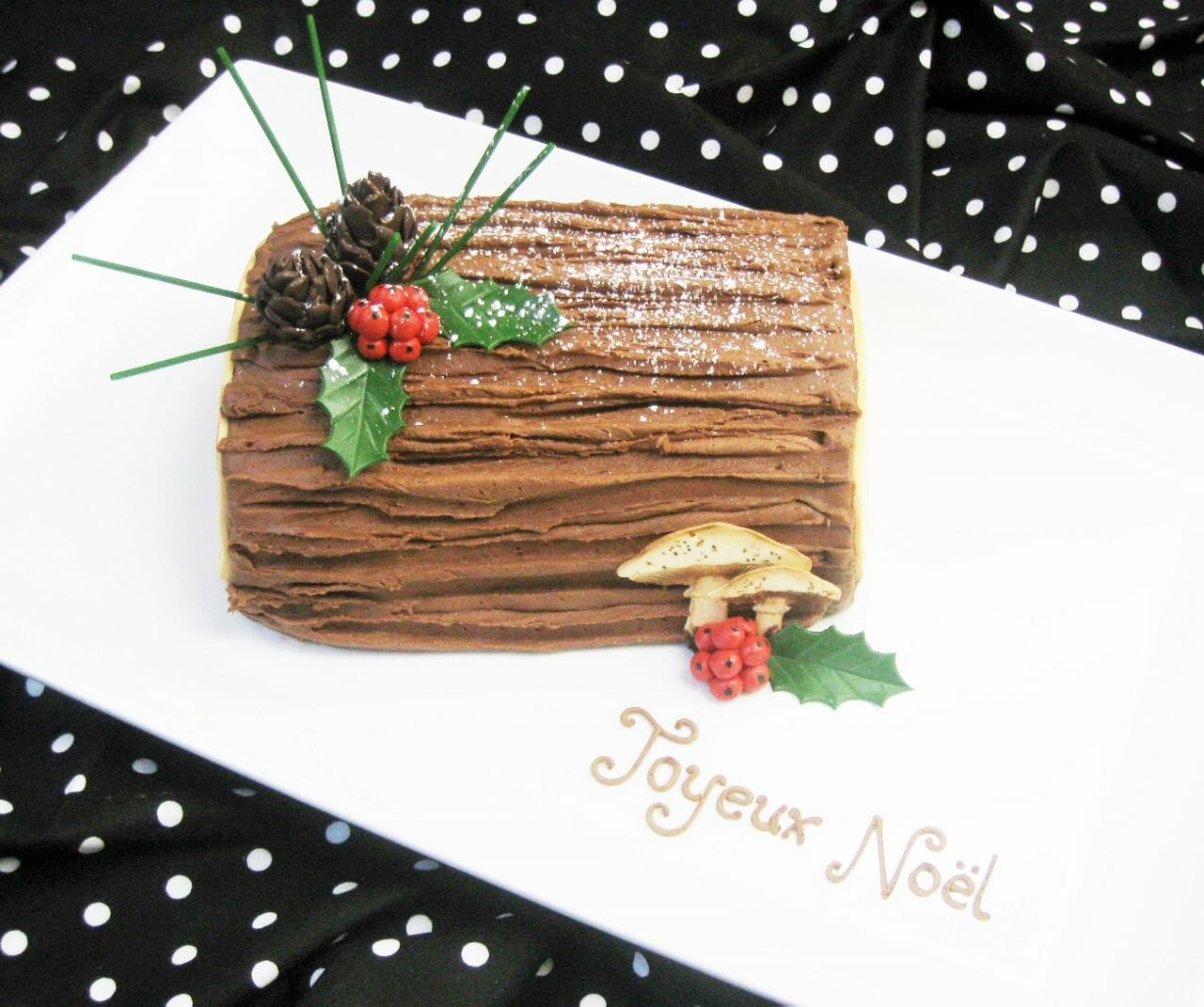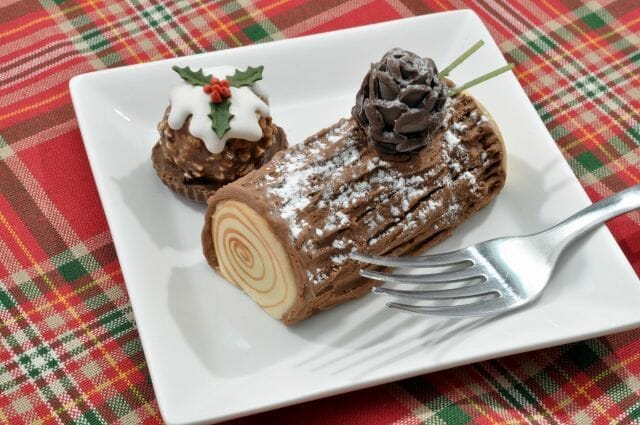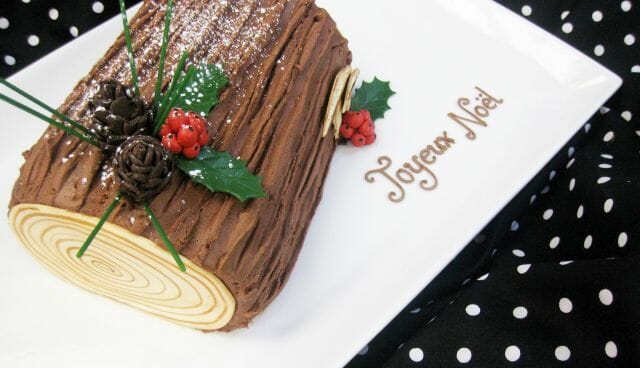Bûche de Noël: A Most Delicious Tree

Yule Log Cake
With the holiday’s right around the corner, I thought I would delve deeper into some holiday cake decorating. To me the obvious choice was the Bûche de Noël or the Yule Log cake. In all honesty, I was not super familiar with this cake until recently. Up until I started working at ISAC, when I heard “Yule Log” I thought of the televised burning log each Christmas (which I did not understand). Before I talk about the actual cake, let’s talk about the history of the Yule Log.
Since the Yule Log is a European tradition, I will start by saying to all of our European readers- I apologize if I get any of the details wrong, and feel free to correct me in the comments below! Ok! Let’s talk tree! The Yule Log seems to have been fairly widespread across Europe, variants of it can be found in England (Yule Clog, Yule Block, Gule Block, and Stock of the Mock), Ireland (Bloc na Nollag), Wales (Boncyff Nadolig), Scotland (Yeel carline), Germany (Christklotz, Christbrand, and Weihnachtsscheit), Spain (Catalonia- Tió de Nadal; Aragon-Tizón de Nadal or Tronca de Nabidá; Occitania-Cachafuòc or Soc de Nadal; Galicia- Cachopo de Nadal), France (Bûche de Noël), and most of Southern Europe (Tuscany- Festa del Ceppo) and the Balkans (Serbia- badnjck; Bulgaria-Budnik). Whew, I hope I got all that right!
Dating way back to the Iron Age in Europe, the Yule Log predates Christianity. Most scholars seem to believe that a huge log (or an entire tree) decorated with holly springs, ivy or pinecones may have been a religious practice to celebrate the winter solstice and usher in spring. The end of the log would have been placed into the hearth- this tree would endure for a long time and provide ample warmth. Often the tree was anointed with wine or salt, and the ashes were kept because they were believed to have medicinal properties and guard against evil. There is some evidence that people may have believed the ashes could protect their wooden homes from lightning strikes.
Bûche de Noël

So, how did the tradition of burning a huge tree inside a home turn into a small, intricately decorated cake? Burning logs around Christmastime did not fall out of practice- my family has a fire on Christmas every year! However, dragging a giant tree into modern homes is a bit… well, impossible. The onset of Christianity did not snuff out the tradition of the Yule Log- modernity did. Modern homes and smaller hearths- or homes with kitchens slowly limited the practice of burning the Yule Log in many places. However, smaller hearths and kitchens were conducive to baking! Some time, somewhere (probably France) – a log shaped cake, decorated with meringue mushrooms and marzipan holly made its debut. I couldn’t find any information on who “invented” this cake, or where it really originated. Some sources believe it was created in the 19th century, but another source states that all the ingredients used to make a decorate a traditional Bûche de Noël were available as early as the 17th century, so perhaps the cake is a few hundred years older. Above is a mini Yule Log Cake made by Chef Nicholas with Chocolate Pinecone and Pine needles (made with Angel Hair pasta pushed into a piping bag of softened green fondant and then inserted into the Bûche de Noël), and in the background is a teeny Plum Pudding.
The Bûche de Noël may not be sharing the secrets of its invention, but why don’t we talk about how it’s made today. A thin genoise or sponge cake is rolled with cream or jam as a filling, and then is covered in chocolate buttercream. This buttercream is textured to look like bark. Often an end piece will be sliced off and placed on the top or side of the main “log” to resemble a branch. The ends of the cake log and branch are decorated to look like tree rings. The log is further decorated with mushrooms, holly, cobwebs, tree bark, and pinecones- all made out of delicious things like marzipan, meringue, fondant, buttercream, chocolate, etc.

A few years ago, I noticed a log shaped cake at my local grocery store. It was a sorry looking cake, and I thought, who would want a cake in the shape of a tree?! Well, then I started working for Chef Nicholas and saw his Bûche de Noël cakes. I immediately understood- his cake was amazingly beautiful! That, coupled with learning the history behind the Yule Log converted me! I love seeing Bûche de Noël cakes now. Go ahead and google image that- some are truly incredible.
I’d love to know if any of our readers make Bûche de Noël at Christmas! Please do share if you do in the comments below. Or maybe start a new holiday tradition and make one for your family this year! It’s certainly a better idea than dragging an entire tree into your living room and setting it on fire. Just saying…
Sweetly yours,
Stephanie
Don’t just follow our blog! Follow Chef Lodge on Facebook, Instagram, Pinterest, Twitter, Flickr, and Tumblr!







Ours are called the Sandpearl Yule Log. What upsets me is we have to pre-slice our cakes for tHe banquet event, so it’s loses some of its look. Our Yule Log is more modern than the traditional stump, tried doing it that way a few years ago and after cutting not so nice.
So glad you posted this. I’m making one for guests on Sunday and now I can explain the tradition and history with confidence. Thanks for sharing.
I enjoyed this article and learning the origins of this Holiday tradition. Please consider showing how to decorate a Buche de Noel during an Open House… that would be wonderful!
Thank you. I have a few orders of this around Christmas.